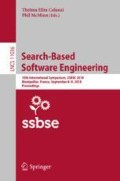Abstract
Genetic Programming has been successfully applied to fault localisation to learn ranking models that place the faulty program element as near the top as possible. However, it is also known that, when localisation results are used by Automatic Program Repair (APR) techniques, higher rankings of faulty program elements do not necessarily result in better repair effectiveness. Since APR techniques tend to use localisation scores as weights for program mutation, lower scores for non-faulty program elements are as important as high scores for faulty program elements. We formulate a multi-objective version of GP based fault localisation to learn ranking models that not only aim to place the faulty program element higher in the ranking, but also aim to assign as low scores as possible to non-faulty program elements. The results show minor improvements in the suspiciousness score distribution. However, surprisingly, the multi-objective formulation also results in more accurate fault localisation ranking-wise, placing 155 out of 386 faulty methods at the top, compared to 135 placed at the top by the single objective formulation.
Access this chapter
Tax calculation will be finalised at checkout
Purchases are for personal use only
Notes
- 1.
Note that our primary fitness function is essentially the mean wef computed for faults in the training data-set.
References
Deb, K., Pratap, A., Agarwal, S., Meyarivan, T.: A fast and elitist multiobjective genetic algorithm: NSGA-II. IEEE Trans. Evol. Comput. 6(2), 182–197 (2002)
Fortin, F.A., De Rainville, F.M., Gardner, M.A.G., Parizeau, M., Gagné, C.: DEAP: evolutionary algorithms made easy. J. Mach. Learn. Res. 13(1), 2171–2175 (2012)
Just, R., Jalali, D., Ernst, M.D.: Defects4J: a database of existing faults to enable controlled testing studies for java programs. In: Proceedings of the 2014 International Symposium on Software Testing and Analysis, ISSTA 2014, pp. 437–440. ACM, New York (2014)
Moon, S., Kim, Y., Kim, M., Yoo, S.: Ask the mutants: mutating faulty programs for fault localization. In: Proceedings of the 2014 IEEE International Conference on Software Testing, Verification, and Validation, ICST 2014, pp. 153–162. IEEE Computer Society, Washington, D.C. (2014)
Praditwong, K., Harman, M., Yao, X.: Software module clustering as a multi-objective search problem. IEEE Trans. Softw. Eng. 37(2), 264–282 (2010)
Qi, Y., Mao, X., Lei, Y., Wang, C.: Using automated program repair for evaluating the effectiveness of fault localization techniques. In: Proceedings of the 2013 International Symposium on Software Testing and Analysis, ISSTA 2013, pp. 191–201. ACM, New York (2013)
Sohn, J., Yoo, S.: FLUCCS: using code and change metrics to improve fault localization. In: Proceedings of the 26th International Symposium on Software Testing and Analysis, ISSTA 2017, pp. 273–283. ACM (2017)
Weimer, W., Nguyen, T., Goues, C.L., Forrest, S.: Automatically finding patches using genetic programming. In: Proceedings of the 31st IEEE International Conference on Software Engineering (ICSE 2009), pp. 364–374, 16–24 May 2009
Wong, W.E., Gao, R., Li, Y., Abreu, R., Wotawa, F.: A survey on software fault localization. IEEE Trans. Softw. Eng. 42(8), 707 (2016)
Xie, X., Chen, T.Y., Kuo, F.C., Xu, B.: A theoretical analysis of the risk evaluation formulas for spectrum-based fault localization. ACM Trans. Softw. Eng. Methodol. 22(4), 31:1–31:40 (2013)
Yoo, S.: Evolving human competitive spectra-based fault localisation techniques. In: Fraser, G., Teixeira de Souza, J. (eds.) SSBSE 2012. LNCS, vol. 7515, pp. 244–258. Springer, Heidelberg (2012). https://doi.org/10.1007/978-3-642-33119-0_18
Acknowledgements
This research was supported by the Korean MSIT(Ministry of Science and ICT), under the National Program for Excellence in SW (2016-0-00018), supervised by the IITP(Institute for Information & communications Technology Promotion).
Author information
Authors and Affiliations
Corresponding author
Editor information
Editors and Affiliations
Rights and permissions
Copyright information
© 2018 Springer Nature Switzerland AG
About this paper
Cite this paper
Choi, K., Sohn, J., Yoo, S. (2018). Learning Fault Localisation for both Humans and Machines Using Multi-objective GP. In: Colanzi, T., McMinn, P. (eds) Search-Based Software Engineering. SSBSE 2018. Lecture Notes in Computer Science(), vol 11036. Springer, Cham. https://doi.org/10.1007/978-3-319-99241-9_20
Download citation
DOI: https://doi.org/10.1007/978-3-319-99241-9_20
Published:
Publisher Name: Springer, Cham
Print ISBN: 978-3-319-99240-2
Online ISBN: 978-3-319-99241-9
eBook Packages: Computer ScienceComputer Science (R0)

